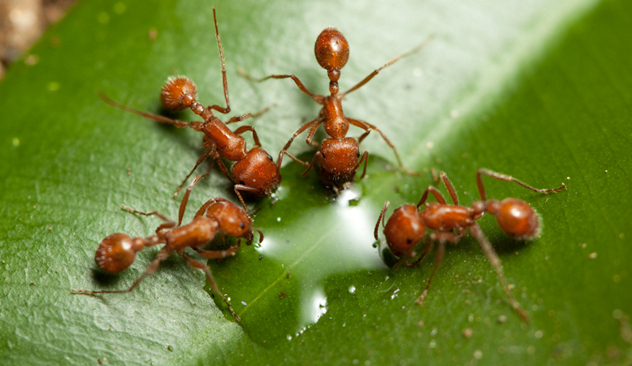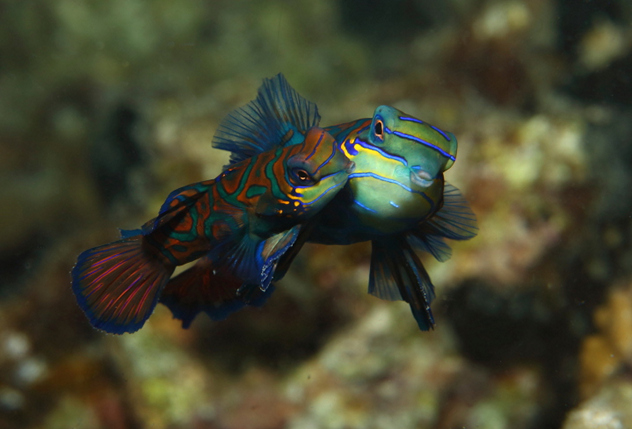 Mysteries
Mysteries  Mysteries
Mysteries  History
History 10 Surprising Stories About the Texas Rangers
 Humans
Humans 10 Philosophers Who Were Driven Mad by Their Own Theories
 Miscellaneous
Miscellaneous 10 Video-Game-Worthy Weapons and Armors from History
 Weird Stuff
Weird Stuff 10 Psychics Who Accurately Predicted Wartime Events
 The Arts
The Arts 10 Pieces of Art Inspired by a Broken Heart
 Health
Health 10 Science Fiction-Sounding New Medical Treatments
 History
History 10 Surprising Facts About the Father of Submarine Warfare
 Space
Space Ten Astonishing New Insights into Alien Worlds
 Weird Stuff
Weird Stuff 10 Bizarre Summer Solstice Rituals Still Practiced Today
 Mysteries
Mysteries Top 10 Haunting Facts About the Ghost Ship MV Alta
 History
History 10 Surprising Stories About the Texas Rangers
 Humans
Humans 10 Philosophers Who Were Driven Mad by Their Own Theories
Who's Behind Listverse?

Jamie Frater
Head Editor
Jamie founded Listverse due to an insatiable desire to share fascinating, obscure, and bizarre facts. He has been a guest speaker on numerous national radio and television stations and is a five time published author.
More About Us Miscellaneous
Miscellaneous 10 Video-Game-Worthy Weapons and Armors from History
 Weird Stuff
Weird Stuff 10 Psychics Who Accurately Predicted Wartime Events
 The Arts
The Arts 10 Pieces of Art Inspired by a Broken Heart
 Health
Health 10 Science Fiction-Sounding New Medical Treatments
 History
History 10 Surprising Facts About the Father of Submarine Warfare
 Space
Space Ten Astonishing New Insights into Alien Worlds
 Weird Stuff
Weird Stuff 10 Bizarre Summer Solstice Rituals Still Practiced Today
10 Unusual Solutions To Animal Problems
All creatures—great and small—come with their own sets of problems, some of which are pretty difficult to solve. From psychological issues to urban encroachment, animal issues are always unique and often require out-of-the-box solutions. So whether you need to save a species or wipe one out for the good of the planet, you have to get creative—like these folks did.
10Fighting Fire Ants

Fact: Everyone hates fire ants. Not only do they pack a powerful sting, but they’re also extremely destructive—like $6-billion-a-year destructive. These miniature monsters snuck aboard cargo ships sailing up from South America and spread out across the American South at terrifying speed. Here’s a statistic to frighten your myrmecophobic friends: A single colony of fire ants can boast 250,000 insects, and—in some regions—there are up to 10 colonies per acre.
That’s a nightmare for the 500,000 Americans allergic to fire ant venom. In addition to attacking innocent picnickers, fire ants like to chew on electrical wiring, shorting out household appliances, traffic lights, and sprinkler systems. When they aren’t chomping on wires, they like to eat endangered animals, such as the black-capped vireo—a bird found in states like Texas.
In response to the invasion, the US Department of Agriculture created the Imported Fire Ant and Household Insects Research Unit, which has declared biological warfare on the ants. In 1998, the USDA released Thelohania solenopsae into fire ant colonies across the South. This pathogen infects the workers and attacks the queen, causing her to lay fewer and fewer eggs. The few eggs she does lay are infected with the organism. This nasty parasite is extremely efficient, and can wipe out a colony in nine to 18 months.
In addition to using microscopic assassins, the USDA is launching insect airstrikes against their fiery foes. We’ve learned in the past that phorid flies impregnate ants with larvae that eat and decapitate their host, making Xenomorphs look tame in comparison. The USDA decided to weaponize these flies and sic them on the ants. As of 2011, five different species of phorid flies have been released into the wild.
9Gender-Bending Fish

John Teem and Juan Gutierrez spend their days trying to kill fish—the invasive ones anyway. Invasive fish are conquering the world one lake at a time. These pesky perch and bothersome bass are stealing food from native animals, and wrecking ecosystems. Teem and Gutierrez are hoping to wipe out the invaders with a crazy scheme, involving transsexual fish.
These gender-bending fish showed up in the UK in the 1990s. Scientists discovered that these aquatic sex changes were thanks to birth control pills and hormone replacement therapy. Any hormones not absorbed by the human body are passed on through urine. When millions of women visit the ladies’ room, they’re passing on pollution, which transforms genetically male fish into fully functional females. Teem and Gutierrez are planning to pimp out these fish in hopes of wiping out invasive species across the globe.
The plan goes something like this: While a genetically female fish donates two X chromosomes to her offspring, the male-female will donate an X to half of its eggs and a Y chromosome to the other half. At the same time, his-her partner will also donate an X and Y chromosome. The end result is that you get one-quarter XX females, one-half XY males, and one-quarter YY males—only one in four fish is a girl. Over the course of several years, Teem and Gutierrez hope to breed females out of the equation, making it impossible for invasive populations to reproduce.
Of course, this plan has its drawbacks. The scientists will need an awful lot of intersex fish to make the operation successful, and their whole operation might fall apart if male fish don’t want to play the crying game.
8Chicken Eyeglasses

When cooked, chickens are delicious. While alive, they’re vicious cannibals. Like deranged sports fans, chickens go crazy at the sight of blood. If some unlucky hen nicks herself, she’ll be swarmed by wild-eyed birds, pecked to death, and then—well . . .
This is bad news if you’re a chicken, and it’s worse if you’re a chicken farmer. Nobody’s going to buy a cannibalized bird—not even McDonald’s—so farmers have to find a solution. Most simply “debeak” their birds, using heated blades or infrared energy to cut the tips of the beak. The National Band & Tag Company had a different idea.
Founded in 1902, the National Band & Tag Company sells bands for birds and tags for livestock. In 1939, they addressed the issues of chicken cannibalism and fowl fashion by inventing chicken eyeglasses. Known as Anti-Pix, the glasses were placed on a chicken’s beak. While some were held in place with straps, most relied on stainless steel pins that ran through the chicken’s nostrils. The lenses were bright red, allowing the chickens to see the world through rose-colored glasses.
Not only did this give them an optimistic outlook, but the red lenses muted the color of blood, which cut back on the number of farmyard shankings. However, their vision was only red as long as they kept their heads up. If the chicken bent down to scratch for feed, special hinges allowed the lenses to swing forward, letting the bird see the world in Technicolor.
However, the National Band & Tag Company no longer sells the Anti-Pix glasses, and similar contraptions are illegal in countries like the UK. Such laws bring up a number of interesting questions. Are chicken glasses any worse than the practice of debeaking? And is it worth some discomfort to protect weaker chickens, or should nature be allowed to take its course?
7The Grizzly Bear Electromat

Nobody messes with grizzly bears. These apex predators are armed with flesh-ripping claws and bone-crunching jaws. Nothing can take them down . . . except for trains.
Since 2007, trains have killed 13 bears in Alberta’s Banff National Park. A depressing statistic, made worse by the fact that there are only about 700 left in the entire province. Realizing the need for action, the Canadian Pacific Railway teamed up with Parks Canada, called in a team of biologists and researchers, and is currently spending $1 million to find clever ways to keep grizzlies off the tracks. The company is monitoring bears with GPS collars, attaching cameras to the fronts of trains, and placing whistles along the rail lines to frighten bears away.
But perhaps the most shocking method is the electromat. Researchers rigged up two test sites, made to look like fenced-in train tracks. On the far side of the tracks was a tantalizing hunk of meat, while on the other side was a black-and-yellow electromat. Lured in by the smell of dinner, the bears tried to cross the mat, only to be zapped. So far, four grizzlies have been sent scurrying. One bear returned to the test site a few months later, but didn’t try to cross.
If the test results continue to be positive, scientists hope that these electromats will keep the bears from entering openings along actual fenced-in railways. Park official have already installed an electromat across a major highway, which protects the bears from . . . grisly automobile accidents.
6Robot Fish

Imagine you’re a fish. You’re swimming along with your school, following your leader, when suddenly you and all your buddies are sucked into a turbine and shredded into little pieces. If your leader had only known how dangerous turbines were, then you’d be alive right now. But your leader didn’t know the first thing about turbines, because he’s a fish.
However, Maurizio Porfiri—an assistant professor at the Polytechnic Institute at NYU—knows all about turbines, and has spent the last three years developing a solution. His plan is to create robot fish, which will take over deep sea schools and guide the real fish to safety. While these droids don’t really look like the real deal, they’ve got all the right moves. Porfiri discovered that leader fish beat their tails faster than the rest of the group. These leader fish use their tails to signal directions, and to speed up when they want the school to pay attention.
As long as the robots keep the right speed, the rest of the fish will follow along, allowing these cyber shepherds to guide schools away from underwater dangers. Porfiri even hopes to someday use the same technology to lead birds to new wintering grounds, or herd livestock to safe locations . . . or maybe even guide humans out of dangerous situations, which will be great until Skynet goes online.
5Eating Invasive Species

Fire ants aren’t the only unwelcome critters running up the global bill. Invasive species have caused over $1 trillion in damages. That’s a whopping 5 percent of the global economy—a pretty pricey problem. But while scientists have spent billions searching for answers, Bun Lai of Miya’s Sushi has come up with a simple solution to the invasive species problem: Why not just eat them?
Located in New Haven, Connecticut, Bun Lai’s restaurant offers an eclectic “Invasive Species Menu.” Lai believes the “invasive species are a vast untapped resource for eating,” and he harvests many of the creatures from the ocean outside his restaurant. He was inspired to cook the invaders when he discovered hordes of Asian shore crabs—creatures that killed off the native crustaceans—scurrying across the beach.
Miya’s menu looks like something out of Indiana Jones and the Temple of Doom. For example, he offers “Kiribati Sashimi,” which is sliced-up lionfish. These spiny predators escaped from an aquarium during Hurricane Andrew and have since multiplied off the eastern coast. Lai serves the lionfish with lime juice, peppers, and sesame seeds. And since mute swans have a bad habit of destroying American marshlands, Lai roasts these waterfowl and serves them wrapped in leaves of kudzu—itself an extremely destructive plant.
Finally, there’s the “Peanut Butter and Jelly.” Lai steams feral rabbits (which are destroying croplands), throws in a few jellyfish, and tops the whole thing off with creamy roasted peanut butter. Who knew saving the earth could taste so . . . unique?
4iCPooch

Want to depress all of your friends? Tell them over 13 million dogs suffer from separation anxiety. If you own a dog, chances are pretty good Fido is freaking out every time you go to work.
The same thing happened to Brooke Martin’s golden retriever, Kayla. Every time Brooke left the house, her dog panicked. That’s when Brooke had an epiphany: What if she could talk to Kayla while away from home? Even better, what if she could give Kayla a snack? It was then the 12-year-old inventor set to work on iCPooch—a device that would make things easier on our four-legged friends.
The iCPooch is a PC-slash-vending machine that uses Skype to connect dogs with their masters. The owner calls home on her smart phone, and her face pops up on the iCPooch screen, allowing her to talk to her pets. The contraption also provides canines with a special treat that pops out via a motorized sleeve (think a DVD player armed with a dog biscuit).
Thanks to her age and ingenuity, Brooke’s invention has garnered quite a bit of attention. She presented her idea at a Startup Weekend event in Spokane, and the iCPooch has been featured on CBS, NBC, and MSN—among other news sources. When it finally hits the stores, dogs everywhere will at last be able to relax, and owners won’t come home to find their sneakers covered in teeth marks.
3Operation Migration

1941 was a bad year for whooping cranes. Thanks to habitat loss and unregulated hunting, their numbers fell from 20,000 to a grand total of 15 in less than 200 years. Fortunately, conservationists showed up in the nick of time. By 1970, the 15 had turned into 57. But there was only a single flock. If something catastrophic happened to them, the whooping crane would disappear forever. Scientists needed to start additional flocks, but how would earth-bound humans teach them to fly south in the winter?
The answer was Operation Migration. Founded in 1994, Operation Migration uses airplanes to teach whooping cranes how to navigate North American airways. Pilots guide the birds from Wisconsin to Florida. Before they can take to the air, the cranes have to learn to follow the planes. At a special facility in Maryland, chicks are taught to associate planes with cranes by listening to recordings of adult birds mixed with the sounds of aircraft engines. When they’re older, the cranes are shipped to Wisconsin. Here, pilots drive the ultralight planes inside of their enclosures, encouraging the birds to follow the leader.
After months of practice, the plane takes off, with the cranes following in a V-formation. As the birds fly south, the other members of Operation Migration follow by car. They set up pens at pre-arranged spots, so the cranes can sleep in safety. When the sun rises, the plane takes off again, with the birds close behind. Eventually, the flock lands in Florida, where the cranes spend the winter before heading back to Wisconsin unassisted. (Although why any creature would go back to Wisconsin is an unsolved mystery of science.)
Thanks to the hard work of Operation Migration, the number of birds has multiplied to 500, and older cranes are starting to lead young birds back and forth without any assistance from the planes. Hopefully, the birds will start migrating all by themselves, and Operation Migration will land their planes for good.
2Lion Lights

Most of us think lions are awesome, but not Richard Turere. For 13-year-old Richard, lions are a pain in the neck. You’d think so too, if your job was to guard your family’s livestock on the outskirts of the Nairobi National Park. Ever since his ninth birthday, Richard woke up at dawn, took his father’s cows out to graze, and penned them up at night—only to have lions show up and order a few steaks.
Lions are a pretty big problem for the Maasai farmers living around Nairobi. Life isn’t easy for the big cats either, as angry cattlemen are poisoning them with a deadly pesticide, known as Furadan. It would have been easy for young Richard to buy a bottle of poison. Instead, Richard came up with a creative solution to protect his family’s farm.
At age 11, he realized lions were scared of flickering lights. They wouldn’t come close to his cowshed if someone was outside with a flashlight. In a matter of weeks, he’d rigged up a defense system he proudly named “Lion Lights.” Richard attached LED bulbs to poles and set them around the cowshed. Then he hooked the lights to an indicator box and a car battery, which itself was charged by a solar panel. At night, the LED bulbs flashed off and on (just like a bunch of flashlights), successfully scaring the lions away.
In fact, Richard hasn’t lost a single cow since he put his plan into action. His impressed neighbors even asked him to install “Lion Lights” around their farms. His invention caught on, spreading across Kenya, Zambia, Tanzania, and even India, where people are using them to deter hungry tigers. Eventually, Richard’s “Lion Lights” caught the attention of the Kenya Land Conservation Trust, who helped the teen get a scholarship at one of Kenya’s top schools. He even shared his story at the TED 2013 conference. Richard is a kid who’s going places, and his invention will continue saving cats and cattle across the world. Everybody wins.
1The Monkey Army

The city of New Delhi is overrun with thugs and thieves who break into people’s homes, stealing whatever they please, beating up anyone who gets in the way. Entire neighborhoods live in fear of these street gangs, and citizens are demanding the government do something to stop them. Who are these street punks? Monkeys—rhesus macaques, to be more specific.
New Delhi is full of them. These hairy hellions hitch rides on buses and subways, and they’ve turned the Indian Parliament building into their own personal jungle gym. They sneak into homes and—after tearing the place apart and raiding refrigerators—take off with all the clothes they can carry. They’re also pretty vicious. In 2007, they killed a deputy mayor by knocking him off a terrace, and they forced a 14-year-old girl off the roof of her five-story apartment.
The monkeys love New Delhi, because Hindus feed macaques by hand to honor the monkey god—Hanuman. Thanks to the easy food, the monkeys have lost all fear of humans, and associate big cities with free handouts. They’re also really good at avoiding traps set for them by government officials. Even when they’re caught, they can easily escape from the city’s animal sanctuary. So what do you do when your city is overrun with psycho monkeys? Bring in more monkeys, of course!
The city of New Delhi is using an army of langur monkeys to chase off the pesky macaques. Rhesus monkeys are terrified of langurs, and will scurry away at the sight of one. The langur army is 38 primates strong, and each langur can scare away 50 macaques single-handedly. Their trainers carry them around the city via bicycles, and the langurs provide a variety of services—from guarding sports stadiums to urinating on lawns. Evidently, macaques hate the smell of langur pee, and they’ll stay away from these houses for weeks.
It’s not a perfect solution (the macaques just find another part of the city to vandalize), but the langurs are doing their best to make sure the streets of Delhi are free from monkey business.
Nolan Moore spends a lot of time figuring out ways to keep neighborhood cats out of the trash.








